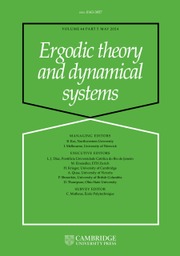No CrossRef data available.
Article contents
Multi-dimensional piecewise contractions are asymptotically periodic
Published online by Cambridge University Press: 30 October 2025
Abstract
Piecewise contractions (PCs) are piecewise smooth maps that decrease the distance between pairs of points in the same domain of continuity. The dynamics of a variety of systems is described by PCs. During the last decade, much effort has been devoted to proving that in parameterized families of one-dimensional PCs, the  $\omega $-limit set of a typical PC consists of finitely many periodic orbits while there exist atypical PCs with Cantor
$\omega $-limit set of a typical PC consists of finitely many periodic orbits while there exist atypical PCs with Cantor  $\omega $-limit sets. In this article, we extend these results to the multi-dimensional case. More precisely, we provide criteria to show that an arbitrary family
$\omega $-limit sets. In this article, we extend these results to the multi-dimensional case. More precisely, we provide criteria to show that an arbitrary family  $\{f_{\mu }\}_{\mu \in U}$ of locally bi-Lipschitz piecewise contractions
$\{f_{\mu }\}_{\mu \in U}$ of locally bi-Lipschitz piecewise contractions  $f_\mu :X\to X$ defined on a compact metric space X is asymptotically periodic for Lebesgue almost every parameter
$f_\mu :X\to X$ defined on a compact metric space X is asymptotically periodic for Lebesgue almost every parameter  $\mu $ running over an open subset U of the M-dimensional Euclidean space
$\mu $ running over an open subset U of the M-dimensional Euclidean space  $\mathbb {R}^M$. As a corollary of our results, we prove that piecewise affine contractions of
$\mathbb {R}^M$. As a corollary of our results, we prove that piecewise affine contractions of  $\mathbb {R}^d$ defined in generic polyhedral partitions are asymptotically periodic.
$\mathbb {R}^d$ defined in generic polyhedral partitions are asymptotically periodic.
MSC classification
Information
- Type
- Original Article
- Information
- Copyright
- © The Author(s), 2025. Published by Cambridge University Press


